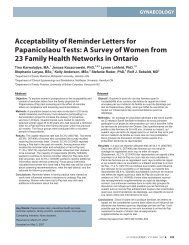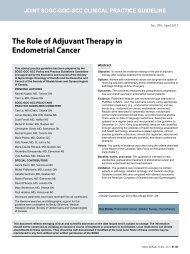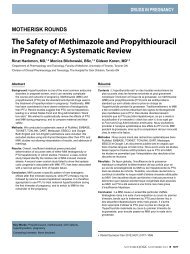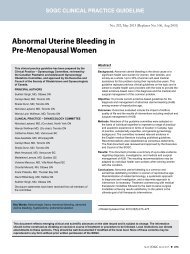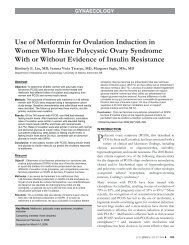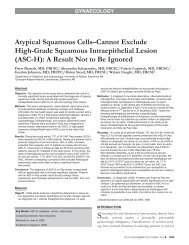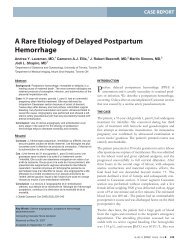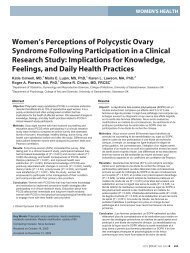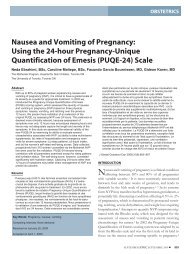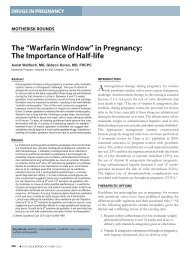Hereditary Angioedema Managed with Low-Dose Danazol ... - JOGC
Hereditary Angioedema Managed with Low-Dose Danazol ... - JOGC
Hereditary Angioedema Managed with Low-Dose Danazol ... - JOGC
Create successful ePaper yourself
Turn your PDF publications into a flip-book with our unique Google optimized e-Paper software.
OBSTETRICS<br />
OBSTETRICS<br />
<strong>Hereditary</strong> <strong>Angioedema</strong> <strong>Managed</strong> <strong>with</strong> <strong>Low</strong>-<strong>Dose</strong><br />
<strong>Danazol</strong> and C1 Esterase Inhibitor Concentrate:<br />
A Case Report<br />
Alon D. Altman, MD, 1 Janice McLaughlin, MD, 2 Robert Schellenberg, MD, 3 Charles Penner, MD, 4<br />
Laura Arbour, MD, 5 Peter Tsang, MD, 6 Penny Ballem, MD, 6 Kenneth I. Lim, MD 7<br />
1 Department of Obstetrics and Gynaecology, Dalhousie University, Halifax NS<br />
2 Department of Obstetrics, St. Joseph’s General Hospital, Comox BC<br />
3 Division of Allergy and Immunology, Department of Medicine, University of British Columbia, Vancouver BC<br />
4 Department of Internal Medicine, St. Joseph’s General Hospital, Comox BC<br />
5 Department of Medical Genetics, University of British Columbia, Vancouver BC<br />
6 Division of Hematology, Department of Medicine, University of British Columbia, Vancouver BC<br />
7 Division of Maternal–Fetal Medicine, Department of Obstetrics and Gynaecology, University of British Columbia, Vancouver BC<br />
Abstract<br />
Background: <strong>Hereditary</strong> angioedema (HAE) is a rare life-threatening<br />
disease that can occur in pregnancy.<br />
Case: A nulliparous woman was diagnosed as having HAE at<br />
22 weeks of gestation after a series of symptomatic episodes.<br />
Following an initial course of C1 esterase inhibitor (C1EI) therapy<br />
for an acute episode of HAE, she was treated <strong>with</strong> danazol for<br />
prophylaxis. <strong>Danazol</strong> did not prevent recurrence of symptoms, and<br />
its use was discontinued after six weeks. Thereafter, the patient<br />
was treated exclusively <strong>with</strong> C1EI at weekly intervals for<br />
exacerbations of her HAE. At 37 weeks’ gestation, she delivered a<br />
healthy 3050 g female neonate. At the time of discharge the female<br />
neonate had no signs of virilization or congenital anomalies.<br />
Conclusion: <strong>Low</strong> dose danazol was ineffective in treating this<br />
woman’s HAE in pregnancy. The use of C1EI in pregnancy is<br />
associated <strong>with</strong> good outcomes.<br />
Résumé<br />
Historique : L’œdème angioneurotique héréditaire (OAH) est une<br />
maladie rare mettant en danger la vie de la patiente et qui peut se<br />
manifester pendant la grossesse.<br />
Cas : On a diagnostiqué, chez une femme nullipare à 22 semaines de<br />
gestation, un cas de OAH à la suite d’une série d’épisodes<br />
symptomatiques. Suivant un traitement initial à l’inhibiteur de<br />
l’estérase C1 (C1EI) en raison d’un épisode aigu d’OAH, on lui a<br />
administré du danazol en prophylaxie. Le danazol n’a pas réussi à<br />
prévenir la récurrence des symptômes; on a donc interrompu<br />
l’administration au bout de six semaines. Par la suite, on a traité la<br />
Key Words: <strong>Danazol</strong>, hereditary angioedema, hereditary<br />
angioneurotic edema, C1 esterase inhibitor deficiency, angioedema<br />
<strong>with</strong>out urticaria, pregnancy<br />
Competing Interests: None declared.<br />
Received on July 11, 2005<br />
Accepted on August 31, 2005<br />
patiente exclusivement à l’aide du C1EI, à intervalles<br />
hebdomadaires, lorsqu’il y avait aggravation de son OAH. À<br />
37 semaines, elle a donné naissance à une fille en santé de<br />
3 050 g. Au moment où la patiente a obtenu son congé, le<br />
nouveau-né ne présentait aucun signe de virilisation ou<br />
d’anomalies congénitales.<br />
Conclusion : L’administration à faible dose de danazol n’est pas<br />
parvenue à traiter l’OAH de cette patiente pendant la grossesse.<br />
L’utilisation du C1EI pendant la grossesse s’est traduite par de<br />
bonnes issues.<br />
J Obstet Gynaecol Can 2006;28(1):27–31<br />
INTRODUCTION<br />
<strong>Hereditary</strong> angioedema (HAE), also known as C1<br />
esterase inhibitor (C1EI) deficiency, is a rare inheritable<br />
disease caused by underproduction (type 1), dysfunction<br />
(type 2), or functional deficiency (type 3, abnormal<br />
protein binding) of C1 esterase inhibitor. This deficiency or<br />
dysfunction leads to episodes of angioedema of the skin,<br />
the gastrointestinal mucosa, and the mucosa of the upper<br />
airway. HAE occurs in approximately one in 50 000 people.<br />
1 Since raised circulating levels of estrogen worsen the<br />
disease, pregnancy can induce an increase in the frequency<br />
and severity of attacks. These attacks of angioedema can be<br />
life-threatening if the airways become involved. In this<br />
report we describe a patient <strong>with</strong> HAE that was diagnosed<br />
in the 22nd week of pregnancy who was managed successfully<br />
<strong>with</strong> multiple doses of C1 esterase inhibitor (C1EI).<br />
JANUARY <strong>JOGC</strong> JANVIER 2006 27
OBSTETRICS<br />
THE CASE<br />
A 22-year-old woman (gravida 2 abortus 1) was referred to<br />
the Maternal–Fetal Medicine (MFM) service at BC<br />
Women’s Hospital (BCWH) at 22 weeks of gestation, <strong>with</strong> a<br />
diagnosis of HAE. After the tenth week of pregnancy, she<br />
had made weekly trips to her local emergency department<br />
because of episodes of lower leg urticaria and edema. The<br />
local internal medicine consultant had made the diagnosis<br />
of HAE in her 21st week of gestation when testing showed<br />
her C1EI activity levels to be well below normal values. The<br />
patient was subsequently referred to the MFM service at<br />
BCWH for ongoing management.<br />
In retrospect, the patient’s past history of symptoms was<br />
typical for individuals <strong>with</strong> HAE. The patient recalled having<br />
her first episode of peripheral angioedema at age 16;<br />
thereafter, she experienced episodes once or twice per year.<br />
The episodes typically began <strong>with</strong> swelling of the hands and<br />
feet that slowly extended proximally, culminating in<br />
abdominal pain, diarrhea, and dyspnea. Occasionally a jigsaw<br />
puzzle-like rash would appear on her chest. She would<br />
present to the local hospital emergency department on<br />
numerous occasions because of these symptoms, which<br />
were treated as allergic reactions. Treatments offered to her<br />
included antihistamines, bronchodilators, and adrenaline,<br />
all <strong>with</strong> little or no effect. On one occasion, she underwent a<br />
diagnostic laparoscopy because of the severity of abdominal<br />
pain. The abdominal pain was later attributed to the bowel<br />
edema that may occur in HAE.<br />
The diagnosis of HAE was finally made at 22 weeks’ gestation<br />
by the local internal medicine consultant who found<br />
her C1EI activity level to be only 0.14 (C1EI activity is a<br />
functional assay expressed as a fraction of enzyme activity<br />
seen in a healthy population, <strong>with</strong> a normal range of<br />
between 0.7 and 1.3). Her past medical history was otherwise<br />
unremarkable. She had recently stopped smoking and<br />
denied use of alcohol or illicit drugs. Later, it was learned<br />
that her father also had HAE, as did a first cousin (whose<br />
parents were the siblings of the patient’s parents). On initial<br />
examination at BCWH, the patient had mild edema of the<br />
feet but no other abnormality. Ultrasound examination<br />
showed a normally grown female fetus <strong>with</strong> normalappearing<br />
amniotic fluid. Following the initial MFM consultation,<br />
the patient had an episode of swelling of the hands<br />
together <strong>with</strong> diarrhea and abdominal pain, and she was<br />
admitted to the antepartum unit of BCWH for urgent treatment.<br />
She was given a dose of C1EI concentrate (1100<br />
units) <strong>with</strong> excellent response. After discussing various<br />
therapeutic options to control her HAE, we elected to begin<br />
low-dose danazol (50 mg/day) prophylaxis <strong>with</strong> a supply of<br />
C1EI available for treatment of acute exacerbations. The<br />
patient was aware of the possibility of virilization of her<br />
female fetus as a consequence of danazol therapy. Arrangements<br />
were then made for the patient’s antenatal care to be<br />
continued in her home community, <strong>with</strong> close liaison<br />
between her primary caregivers and tertiary care<br />
consultants.<br />
After two weeks of danazol therapy, the patient continued<br />
to experience HAE attacks at intervals of approximately<br />
five days. The dose of danazol was increased to<br />
100 mg/day. While on the higher dose, the patient began to<br />
experience symptoms attributed to the use of danazol (acne,<br />
excess weight gain, edema, and irritability). After four weeks<br />
of treatment at the higher dose, a decision was made to stop<br />
the danazol because there was no change in the frequency<br />
or intensity of the attacks, and the side effects were becoming<br />
problematic for the patient. <strong>Danazol</strong> therapy was discontinued<br />
after a total of six weeks of use. Subsequently the<br />
patient’s episodes of HAE were treated exclusively <strong>with</strong><br />
C1EI in single doses of 1100 units. The frequency of the<br />
attacks necessitated C1EI infusions at weekly intervals, and<br />
because of the unstable nature of her disease we planned to<br />
have her undergo labour and delivery in the tertiary care<br />
facility (BCWH). We anticipated that the stress of labour<br />
and delivery would rapidly consume C1EI and that multiple<br />
doses of C1EI in labour would be required. Prophylactic<br />
C1EI was to be given in early labour, prior to any obstetric<br />
surgery, and again immediately after delivery.<br />
The patient returned to BCWH at 36 weeks’ gestation in<br />
threatened labour. Over the following week she was given<br />
C1EI on two more occasions when it appeared that labour<br />
was beginning. At 37 weeks’ gestation, labour was induced<br />
by rupture of membranes after administration of prophylactic<br />
C1EI. After an unremarkable labour, the patient<br />
delivered a 3050 g female neonate <strong>with</strong> Apgar scores of 6, 7,<br />
and 9 at 1, 5, and 10 minutes, respectively. The neonate was<br />
subsequently shown to be healthy and had no signs of genitourinary<br />
anomalies or virilization. Two additional doses of<br />
C1EI were given, one during active labour and another<br />
immediately postpartum. Despite the three doses of C1EI<br />
given to the patient in the peripartum period, she suddenly<br />
developed swelling of the hands and constriction of the<br />
throat on the first postpartum day, requiring more C1EI<br />
therapy. In total, we used 22 doses of C1EI in the patient’s<br />
obstetric care.<br />
The patient was discharged on the third postpartum day in<br />
good condition. Following her pregnancy, the frequency of<br />
episodes of HAE diminished, but the patient did not return<br />
to her pre-pregnancy frequency of attacks for one year. The<br />
mother reports that the child is developing normally in all<br />
respects (at 5 years of age).<br />
28 JANUARY <strong>JOGC</strong> JANVIER 2006
<strong>Hereditary</strong> <strong>Angioedema</strong> <strong>Managed</strong> <strong>with</strong> <strong>Low</strong>-<strong>Dose</strong> <strong>Danazol</strong> and C1 Esterase Inhibitor Concentrate: A Case Report<br />
DISCUSSION<br />
Historically, HAE was known as angioneurotic edema,<br />
highlighting the influence that psychological stress had on<br />
the appearance of symptoms. A deficiency of C1EI leads to<br />
episodes of angioedema in different parts of the body, particularly<br />
the skin, the gastrointestinal mucosa, and the<br />
mucosa of the upper airway. The resulting clinical manifestations<br />
include non-pruritic, non-pitting edema of the<br />
periphery, recurrent severe episodes of nausea, vomiting,<br />
abdominal pain, and upper airway obstruction. In type 1<br />
HAE, there is a deficiency of C1esterase inhibitor, whereas<br />
in type 2, the C1EI is dysfunctional. 1 Type 3 HAE is a functional<br />
deficiency in which C1EI is abnormally bound to<br />
albumin. 2 This subset of HAE is aggravated by endogenous<br />
or exogenous estrogen and therefore worsens <strong>with</strong> estrogen<br />
ingestion, at menarche, and during pregnancy. 3,4<br />
C1 esterase inhibitor is a glycosylated, 104 kDa serine protease<br />
inhibitor that is produced in the liver, in the placenta,<br />
and in macrophages. It is one of the main regulators of the<br />
classical complement pathway. C1EI acts on C1 esterase in<br />
the complement pathway, plasmin in the fibrinolytic pathway,<br />
Factor XI in the coagulation cascade, bradykinin,<br />
Hagemann factor, and kallikrein. 1,2,5 In normal circumstances,<br />
immune complexes trigger the formation of C1<br />
esterase which then acts on the substrates C4 and C2 to<br />
form the complex C2,4 (C3). This complex leads to the activation<br />
of vasoactive peptides and anaphylactoid-like substances.<br />
A deficiency of C1E inhibitor leads to inappropriate<br />
or premature activation of the complement pathway as<br />
C1 esterase activity goes unchecked. 2 Symptoms are the<br />
direct result of tissue edema, usually in the respiratory tract<br />
(larynx, bronchioles), gastrointestinal tract, or skin (face,<br />
limbs, genitalia). Tissue edema leads to symptoms such as<br />
swelling of the face, hands, and tongue, dyspnea, stridor,<br />
hoarseness, pain, nausea, vomiting, colic, and upper respiratory<br />
tract obstruction. Most patients do not develop urticaria,<br />
and symptoms may not develop until well into adolescence.<br />
Many patients attribute attacks to periods of stress<br />
(arising from causes such as trauma, viral illness, or dental<br />
work); the onset and duration of symptoms are variable, but<br />
symptoms usually last from 24 to 48 hours. 1,2 Care must be<br />
taken in pregnant patients to differentiate between HAE<br />
and gastrointestinal or obstetric causes of abdominal pain.<br />
HAE is commonly misdiagnosed as an allergic reaction,<br />
since angioedema is most often associated <strong>with</strong> allergies.<br />
The usual treatments for allergic reactions (such as epinephrine<br />
and antihistamine agents) are ineffective in HAE. The<br />
diagnosis should be suspected if there is a history of recurrent<br />
attacks of peripheral angioedema and abdominal pain<br />
<strong>with</strong>out evidence of exposure to an allergen or in the context<br />
of a family history of similar conditions. The diagnosis<br />
can be confirmed by testing C1EI activity in blood. Indirect<br />
measures of reduced C1EI activity such as low C2 and C4<br />
levels will be seen in all subtypes of HAE. Direct<br />
immunohistochemical quantification of C1EI will confirm<br />
a deficiency such as seen in type 1, but normal to elevated<br />
levels in type 2 and 3. A functional test of C1EI activity<br />
(measured as a fraction of normal activity) will show significantly<br />
reduced activity in all forms of HAE and in practical<br />
terms is the most useful test because it is specific for the disorder<br />
and will be reduced in all subtypes. 1–3<br />
Long-term treatment for this condition includes the use of<br />
antifibrinolytics such as e-aminocaproic acid (EACA) or<br />
tranexamic acid, substituted androgens (e.g., methyltestosterone,<br />
fluoxymesterone, oxymetholone), synthetic<br />
androgens (e.g., danazol, stanozolol) or fresh frozen plasma<br />
(FFP) transfusions. 1,2,5 For acute attacks or short-term prophylaxis,<br />
fresh frozen plasma (FFP), C1EI, or the kallikrein<br />
inhibitor aprotinin have been used. C1EI is currently recommended<br />
as prophylaxis for surgery or any anaesthetic<br />
procedure. 1,2,5 Fresh frozen plasma may also be given but<br />
can precipitate attacks because of the complement component<br />
of the infusion. 1,2,5 Further management measures<br />
include decreasing estrogen intake and maintaining good<br />
dental health. 2 Commonly used medications for other<br />
forms of angioedema (antihistamines, steroids, epinephrine)<br />
are not effective in HAE. 1,2,5<br />
Several issues complicate the management of HAE during<br />
pregnancy. The effect of pregnancy on HAE seems variable,<br />
as reports claim that the condition may get better or<br />
worse <strong>with</strong> pregnancy. 2–6 There is a limited number of case<br />
reports of HAE in pregnancy, 5–12 so management suggestions<br />
are based on expert opinion. HAE itself has never<br />
been associated <strong>with</strong> any congenital anomalies. 5 It is currently<br />
recommended that all prophylactic treatments should<br />
be stopped because of possible teratogenicity, but if prophylaxis<br />
in pregnancy is required the theoretical treatment<br />
options include tranexamic acid, EACA, or FFP, 2,13 <strong>with</strong><br />
C1EI being reserved for acute attacks. 2,7,13 Termination of<br />
pregnancy is an option. 11 Prophylactic C1EI should be<br />
given under conditions of physical stress such as labour or<br />
surgery. 2 A multidisciplinary approach to management is<br />
warranted.<br />
In the present case, prophylactic EACA was considered but<br />
not used. The risk of venous thrombosis when using an<br />
antifibrinolytic agent in pregnancy argues against its use. In<br />
addition, EACA is a class C teratogen. 14 EACA is considered<br />
to be less effective than other options, as it does not<br />
increase C1EI levels but rather inhibits C1 and plasmin activation,<br />
<strong>with</strong> consequent sparing of C1 inhibitor usage. 2<br />
Fresh frozen plasma is considered a poor therapeutic<br />
option because of (1) the risk of transfusion-related<br />
JANUARY <strong>JOGC</strong> JANVIER 2006 29
OBSTETRICS<br />
complications or infections; (2) the relatively small amount<br />
of C1E1 per unit of FFP, necessitating multiple units given<br />
frequently (up to 18 units over 2.5 months in one study 8 );<br />
and (3) the volume load imposed upon pregnancy, and<br />
hence the theoretical risk of iatrogenic pulmonary edema<br />
following multiple unit transfusion. We cautiously elected<br />
to try danazol prophylaxis as it was felt to be a superior prophylactic<br />
agent. <strong>Danazol</strong> carries a known teratogenic risk to<br />
a female fetus (class X agent 14 ), but we felt, after careful<br />
review of the literature, that the risk would be considerably<br />
lower if danazol was given at this gestational age and<br />
dosage.<br />
<strong>Danazol</strong> (50–800 mg/day) appears to be an effective treatment<br />
for HAE and is considered superior to EACA and<br />
tranexamic acid as it induces an increase in hepatic production<br />
of C1EI. 1,2 There is evidence to suggest that danazol<br />
causes masculinization of female fetuses (clitoromegaly,<br />
fused labia, urogenital sinus opening at base of clitoris) if<br />
used in pregnancy. 14 Reported rates of virilization of female<br />
fetuses exposed to danazol in utero have ranged from<br />
17.8% (<strong>with</strong> daily maternal doses of danazol of 200 mg or<br />
more) 15 to 27.8% (<strong>with</strong> daily maternal doses of 800 mg). 16<br />
<strong>Danazol</strong> appears to act by inducing a transient block of the<br />
activity of 21-mono-oxygenase and 11-mono-oxygenase. 17<br />
It has been used to treat thrombocytopenia of pregnancy<br />
due to connective tissue disease. 18 There is one reported<br />
case of prophylactic danazol use in pregnancy complicated<br />
by HAE, but in that case it was used only for prophylaxis in<br />
labour. 6 We felt that the teratogenic risk in this case might<br />
be considerably lower than reported. Firstly, the dose of<br />
danazol we were to use was lower than the doses reported in<br />
cases of fetal virilization. The lowest dose associated <strong>with</strong> a<br />
case of virilization was 200 mg/day. 14 Secondly, virilization<br />
has tended to occur when exposure to the medication is<br />
prolonged and takes place between about 8 and 18 weeks of<br />
pregnancy. 14 We did not begin therapy until the 23rd week<br />
of pregnancy, when the fetal genitalia are more developed<br />
and possibly less vulnerable to the teratogenic effects.<br />
Unfortunately, danazol prophylaxis was not well tolerated<br />
by the patient and it was discontinued.<br />
C1EI is a purified human plasma product indicated for<br />
acute attacks and long-term prophylaxis of HAE in pregnant<br />
women and in children. 6 The recommended dose is<br />
1000 to 1500 units given intravenously. 2,7,19 Cox reported a<br />
successful outcome of a pregnancy in which C1EI<br />
1000 units was given intravenously at the start of the second<br />
stage of labour and another 1000 units at the conclusion of<br />
the third stage. 7 Five days after delivery, the patient had an<br />
unexplained attack of abdominal pain that may have been<br />
due to an attack of HAE. Prophylactic medication was not<br />
used in this case and the fetus was a male. Chappatte and de<br />
Sweit reported successful outcomes in two pregnancies<br />
<strong>with</strong> HAE. 5 In neither pregnancy was prophylactic medication<br />
used, but in one C1EI was used to treat an acute attack<br />
at 23 weeks (1000 units) and was then given as prophylaxis<br />
after Caesarean section (1500 units). 2,6 Thus, there is some<br />
evidence for its effectiveness and safety in pregnancy. In the<br />
present case, we used quantities of C1EI that had not previously<br />
been reported in pregnant patients, <strong>with</strong> no apparent<br />
ill effects to mother or fetus.<br />
CONCLUSION<br />
This is the first documented case of an attempt to use<br />
danazol as prophylactic antenatal treatment in a pregnancy<br />
complicated by multiple acute episodes of HAE. The use of<br />
danazol in pregnancy is currently contraindicated, although<br />
in doses of less than 200 mg/day and <strong>with</strong> exposure beginning<br />
only after the 20th week of gestation, the teratogenic<br />
effects may be minimized. <strong>Danazol</strong> therapy was discontinued<br />
because it was ineffective for this patient, but the exposure<br />
did not lead to virilization of a female newborn. This<br />
patient, unlike those in other reports, had multiple and frequent<br />
episodes of HAE that were managed <strong>with</strong> multiple<br />
treatment courses of C1EI (22 doses prior to delivery) and<br />
had a successful outcome of pregnancy. Such extensive use<br />
of C1EI in pregnancy has not been previously reported.<br />
This combination of therapy succeeded in maintaining a<br />
stable pregnancy and the delivery of a normal female neonate.<br />
Further documentation of the effects of low-dose<br />
danazol in pregnancy is required, as is documentation of the<br />
safety and efficacy of C1EI.<br />
ACKNOWLEDGEMENTS<br />
The woman whose story is told in this case report has provided<br />
signed permission for its publication.<br />
REFERENCES<br />
1. Carugati A, Pappalardo E, Zingale LC, Cicardi M. C1-inhibitor deficiency<br />
and angioedema. Mol Immunol 2001;38(2–3):161–73.<br />
2. Fay A, Abinun M. Current management of hereditary angio-oedema (C’1<br />
esterase inhibitor deficiency). J Clin Pathol 2002;55(4):266–70.<br />
3. Binkley KE, Davis A, III. Clinical, biochemical, and genetic characterization<br />
of a novel estrogen-dependent inherited form of angioedema. J Allergy Clin<br />
Immunol 2000;106(3):546–50.<br />
4. Goring HD, Bork K, Spath PJ, Bauer R, Ziemer A, Hintner H, et al.<br />
[<strong>Hereditary</strong> angioedema in the German-speaking region] Hautarzt<br />
1998;49(2):14–22.<br />
5. Chappatte O, de Swiet M. <strong>Hereditary</strong> angioneurotic oedema and pregnancy.<br />
Case reports and review of the literature. Br J Obstet Gynaecol<br />
1988;95(9):938–42.<br />
6. Boulos AN, Brown R, Hukin A, Williams RM. <strong>Danazol</strong> prophylaxis for<br />
delivery in hereditary angioneurotic oedema. Br J Obstet Gynaecol<br />
1994;101(12):1094–5.<br />
7. Cox M, Holdcroft A. <strong>Hereditary</strong> angioneurotic oedema: current<br />
management in pregnancy. Anaesthesia 1995;50(6):547–9.<br />
30 JANUARY <strong>JOGC</strong> JANVIER 2006
<strong>Hereditary</strong> <strong>Angioedema</strong> <strong>Managed</strong> <strong>with</strong> <strong>Low</strong>-<strong>Dose</strong> <strong>Danazol</strong> and C1 Esterase Inhibitor Concentrate: A Case Report<br />
8. Galan HL, Reedy MB, Starr J, Knight AB. Fresh frozen plasma prophylaxis<br />
for hereditary angioedema during pregnancy. A case report. J Reprod Med<br />
1996;41(7):541–4.<br />
9. Hsieh FH, Sheffer AL. Episodic swelling in a pregnant woman from<br />
Bangladesh: evaluation and management of angioedema in pregnancy.<br />
Allergy Asthma Proc 2002;23(2):157–61.<br />
10. Nalbanski B, Tsekova K, Vuzharova R, Ivanov S, Dimitrov A. [The rare<br />
case of successful pregnancy and delivery in patient <strong>with</strong> hereditary<br />
angioedema] Akush Ginekol (Sofiia) 2002;41(5):39–42.<br />
11. Raychaudhuri K, Buck P, Pumphrey RS. Termination of pregnancy in a<br />
patient <strong>with</strong> hereditary angioedema. Br J Hosp Med 1997;58(6):287–8.<br />
12. Sharon-Guidetti A, Manor H, Cohen N, Yona E. Ultrasonography in<br />
hereditary angioneurotic edema during pregnancy. Am J Obstet Gynecol<br />
1993;169(2 Pt 1):433.<br />
13. Palmer GW, Claman HN. Pregnancy and immunology: selected aspects.<br />
Ann Allergy Asthma Immunol 2002;89(4):350–9.<br />
14. Briggs GG, Freeman RK, Yaffe SJ. Drugs in pregnancy and lactation. 4th<br />
ed. Philadelphia: Williams and Wilkens; 1994.<br />
15. Brunskill PJ. The effects of fetal exposure to danazol. Br J Obstet Gynaecol<br />
1992;99(3):212–5.<br />
16. Rosa FW. Virilization of the female fetus <strong>with</strong> maternal danazol exposure.<br />
Am J Obstet Gynecol 1984;149(1):99–100.<br />
17. Castro-Magana M, Cheruvanky T, Collipp PJ, Ghavami-Maibodi Z, Angulo<br />
M, Stewart C. Transient adrenogenital syndrome due to exposure to danazol<br />
in utero. Am J Dis Child 1981;135(11):1032–4.<br />
18. Insiripong S, Chanchairujira T, Bumpenboon T. <strong>Danazol</strong> for<br />
thrombocytopenia in pregnancy <strong>with</strong> underlying systemic lupus<br />
erythematosus. J Med Assoc Thai 1996;79(5):330–2.<br />
19. Immuno AG: C1-esterase inhibitor TIM 3 Human Immuno [Product<br />
Monograph]. Vienna, Austria: Immuno AG; 1996.<br />
JANUARY <strong>JOGC</strong> JANVIER 2006 31



